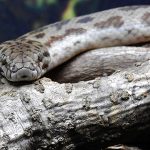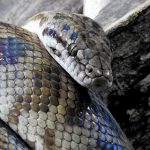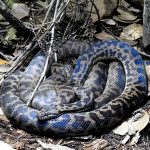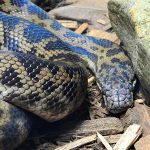SPOTTED PYTHON
The Spotted Python – A Closer Look
The Spotted Python, sometimes called the eastern Children’s python, is a fascinating and often misunderstood resident of Australia’s diverse landscapes.
Appearance and Identification
Size & Shape:
Adults typically measure between 90 to 140 centimetres in length, making them one of the smaller python species in Australia. Their bodies are slender and agile, built perfectly for navigating both rocky outcrops and dense undergrowth.Distinctive Pattern:
Imagine a pale canvas, dappled with dark brown or black spots of varying sizes and shapes. This pattern serves as natural camouflage, helping the python blend into leaf litter or the mottled shadows of rocks.Sensory Description:
If you were to observe a Spotted Python up close, you might notice the smooth, cool texture of its scales, each one reflecting a subtle sheen. In the quiet of dusk, the gentle rustle as it moves through dry leaves adds a soft, almost whispering sound to the Australian bush.
Habitat and Range
Distribution:
The Spotted Python calls a broad stretch of Australia home, from the tropical north of Western Australia and the Northern Territory, across to Queensland and the northern reaches of New South Wales.Habitats:
These adaptable snakes thrive in a variety of settings:- Open woodlands, where dappled sunlight filters through eucalyptus trees
- Rocky escarpments, providing crevices for shelter and ambush
- Grasslands, alive with the scents of wildflowers and sun-warmed earth
Diet and Hunting Behaviour
Diet:
As carnivores, Spotted Pythons target small vertebrates. Their menu includes:- Tiny mammals scurrying at dusk
- Resting birds nestled in low shrubs
- Lizards basking on warm stones
- Occasionally, frogs found near water sources
Hunting Technique:
Devoid of venom, these pythons rely on their powerful muscles to constrict prey. At night, when the world quietens, they become active hunters, using heat-sensitive pits along their jaws to detect the warmth of nearby animals.
Reproduction and Lifecycle
Reproductive Strategy:
Spotted Pythons are oviparous, laying eggs rather than giving birth to live young.Breeding Season:
During the warmer months, females lay between 6 and 15 eggs in hidden, humid spots—often beneath rocks or within decaying logs. The eggs incubate for several months, absorbing the surrounding warmth until tiny hatchlings emerge, ready to fend for themselves.
Conservation and Coexistence
| Threats | Protection Status |
|---|---|
| Habitat loss | Protected |
| Fragmentation | Illegal to remove |
Challenges:
Expanding cities and farmland can fragment the snake’s habitat, making survival more difficult. As a result, the Spotted Python is protected under Australian law. It is illegal to harm, capture, or relocate them without proper permits.Living Together:
If you encounter a Spotted Python, remember:- Maintain a respectful distance
- Observe quietly, allowing the snake to go about its activities undisturbed
- Follow local guidelines to ensure both your safety and the well-being of the snake
A Final Thought
The Spotted Python, with its gentle nature and exquisite markings, is a quiet guardian of Australia’s wild places. By respecting and protecting these remarkable reptiles, we help preserve the intricate web of life that makes the Australian bush so unique and vibrant.
Every encounter with wildlife is a chance to learn, appreciate, and act as stewards for the natural world.




